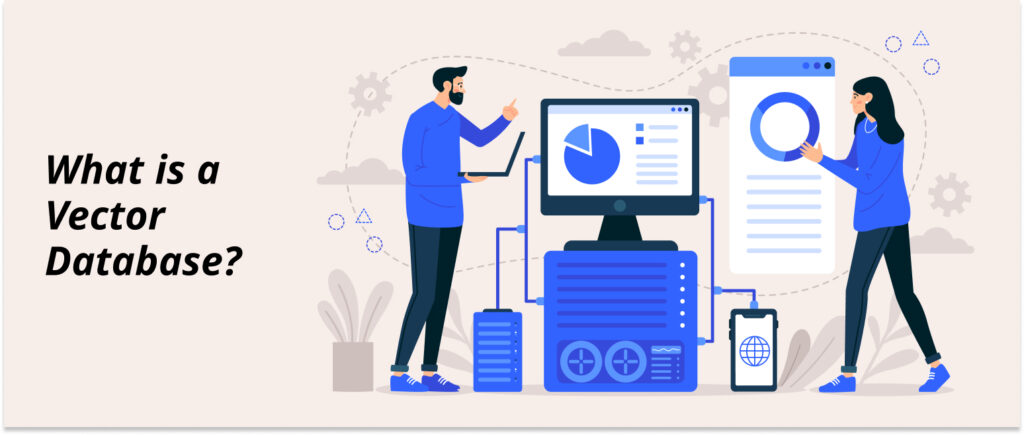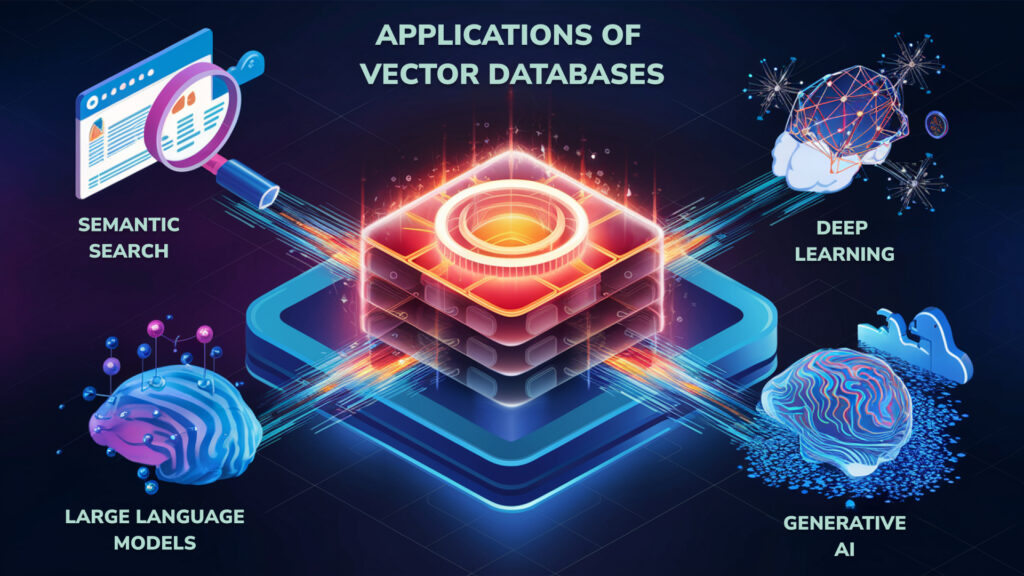Imagine you have a massive collection of data, and you need to find specific information quickly and accurately. This challenge is akin to finding a needle in a haystack, but vector databases make this task significantly easier.
This article explores all that you need to know about a vector database, exploring what they are, how they work, their applications, advantages, and the top vector databases used in AI. Our ecommerce development company has compiled an understanding about how vector databases can revolutionize your data management and retrieval processes.
What is a Vector Database?

Developers designed a vector database to store and manage high-dimensional vectors. Vectors, in this context, are arrays of numbers representing data in a multi-dimensional space. These vectors often come from machine learning models that transform complex data such as images, text, and audio into numerical representations. The primary goal of a vector database is to enable efficient and accurate similarity searches, making it a critical component in various AI applications, including semantic search and recommendation systems.
How Do Vector Databases Work?

Understanding the inner workings of vector databases involves exploring how they handle data ingestion, storage, indexing, and query processing. By transforming raw data into vectors and using specialized indexing techniques, vector databases can perform rapid similarity searches.
— Data Ingestion and Storage:
The journey begins with converting raw data into vectors using machine learning models during data ingestion. These models, such as neural networks, extract essential features from the data and output them as vectors. Once the system generates these vectors, it stores them in the vector database, optimized for handling large-scale vector datasets.
— Indexing:
To ensure quick retrieval, vector databases employ specialized indexing techniques. One popular method is Approximate Nearest Neighbor (ANN) algorithms, which partition the vector space into smaller, manageable sections. This partitioning allows for rapid identification of the nearest vectors to a given query vector, significantly speeding up the search process compared to brute-force methods.
— Query Processing:
When users submit a query, the system transforms it into a vector using the same model that processed the initial data. The vector database then searches for vectors closest to the query vector based on a chosen similarity metric, such as cosine similarity or Euclidean distance. The result is a set of vectors that are most similar to the query, facilitating efficient retrieval of relevant information.
Where are Vector Databases Used?

Vector databases have diverse applications across various fields. This section further highlights these use cases in detail:
Semantic Search
In semantic search, vector databases enhance search accuracy by understanding the context and meaning behind queries. Traditional keyword-based searches often miss the mark when it comes to nuance and intent. By converting both queries and documents into vectors, vector databases can identify semantically similar documents, even if they don’t share the same keywords. This leads to more relevant search results and a better user experience, something any ecommerce development company can appreciate.
Machine Learning and Deep Learning
Vector databases are invaluable in machine learning and deep learning, where managing and querying large-scale embeddings is crucial. Embeddings are dense vectors representing intricate patterns within data, used in applications like image recognition, natural language processing, and recommendation systems. Storing and indexing these embeddings in a vector database ensures efficient model training, evaluation, and deployment.
Large Language Models and Generative AI
Large language models (LLMs) and generative AI produce high-dimensional embeddings representing complex linguistic patterns. Vector databases manage these embeddings, enabling efficient storage, retrieval, and similarity search. Applications include language translation, text generation, and conversational AI, where quick access to relevant embeddings is essential for performance and accuracy.
What Are the Advantages of Using a Vector Database?

Vector databases offer numerous benefits, including speed, efficiency, scalability, accuracy, and flexibility. Read on to know why businesses and developers should consider using vector databases.
- Speed and Efficiency: Developers optimize vector databases for fast similarity searches, making them ideal for applications requiring real-time or near-real-time responses.
- Scalability: They can handle large-scale datasets, ensuring that performance remains consistent as data volume grows.
- Accuracy: Advanced indexing and search algorithms improve the accuracy of retrieval, leading to better results in applications like semantic search and recommendation systems.
- Flexibility: Vector databases can manage various data types transformed into vectors, including text, images, and audio, making them versatile for multiple use cases.
- Integration with AI: They seamlessly integrate with machine learning workflows, enhancing the capabilities of AI models and applications.
Top 5 Vector Databases Being Used in AI

Several vector databases stand out for their performance and capabilities in AI applications. The following section introduces the top five vector databases:
1. Qdrant
Qdrant is an open-source vector database designed for efficient similarity search and scalable indexing. It supports various vector search algorithms and integrates well with machine learning frameworks, making it a popular choice for AI applications.
2. Pinecone
Pinecone is a managed vector database service that offers high-performance similarity search and real-time analytics. Its ease of use, scalability, and robust API make it a preferred solution for developers and data scientists working on AI and machine learning projects.
3. Weaviate
Weaviate is an open-source vector database that combines vector search with a knowledge graph, allowing for context-aware queries and enhanced data relationships. It supports various data types and integrates with popular machine learning models, making it versatile for different applications.
4. Milvus
Milvus is an open-source vector database optimized for high-performance similarity search and large-scale data management. It supports various index types and search algorithms, making it suitable for applications like image retrieval, recommendation systems, and natural language processing.
5. Faiss
Facebook AI Research developed Faiss (Facebook AI Similarity Search), a library for efficient similarity search and clustering of dense vectors. Researchers and industry professionals widely use it for applications requiring fast and accurate vector search.
Frequently Asked Questions
A vector database is a specialized data storage system designed to manage high-dimensional vectors, which are arrays of numbers representing data in a multi-dimensional space. These vectors are often generated by machine learning models and are used for efficient similarity searches.
Traditional databases store structured data such as text and numbers, whereas vector databases store numerical representations of complex data like images and text. Vector databases are optimized for similarity searches, unlike traditional databases that are optimized for exact matches.
Yes, vector databases are designed for fast similarity searches, making them suitable for real-time or near-real-time applications, such as real-time recommendations and interactive search interfaces.
Yes, vector databases can enhance ecommerce applications by improving search accuracy, enabling personalized recommendations, and optimizing data retrieval processes. Ecommerce development companies can leverage vector databases to offer superior services.
Conclusion
Vector databases are transforming the way we manage and retrieve high-dimensional data. By offering efficient storage, indexing, and retrieval of vectors, they empower a wide range of AI applications, from semantic search to generative AI. As the demand for intelligent and context-aware systems grows, vector databases will become increasingly vital, driving innovation and enhancing the capabilities of AI solutions.
Understanding the intricacies of vector databases can give your business a competitive edge. By integrating this technology, with the help of an ecommerce development agency you can enhance your search capabilities, optimize your machine learning workflows, and deliver superior services to your clients. Embrace the power of vector databases and watch your data management capabilities soar to new heights.
Stay Tuned for Latest Updates
Fill out the form to subscribe to our newsletter





